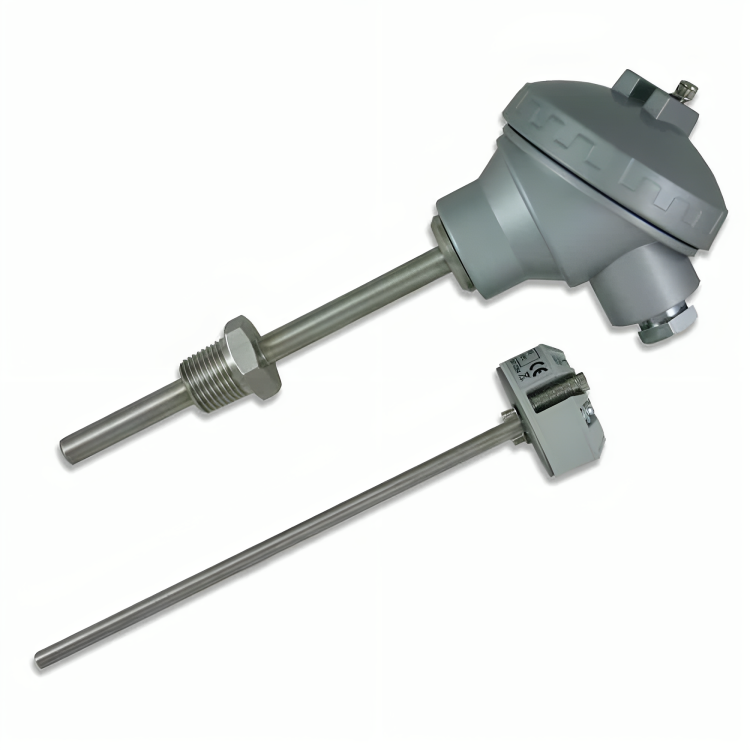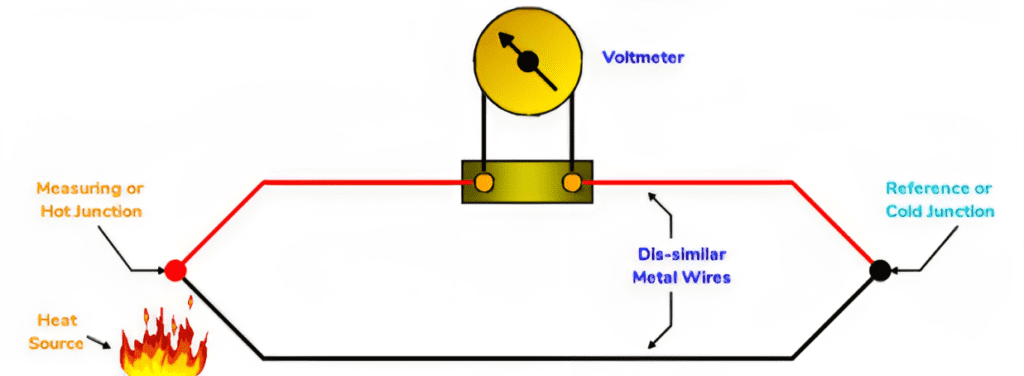Thermocouples are essential devices used for measuring temperature. They generate an electromotive force (EMF) when two different metals are joined, and the temperature changes. Thermocouples make temperature measurement simple, cost-effective, and efficient. In this blog post, we will provide valuable information about thermocouples, thermocouple types, how they work, and their applications.
What Is a Thermocouple Temperature Sensor ?
Thermocouples are a type of electrical sensor used for measuring electrical conductivity. Their primary function is to measure temperature. A thermocouple is a sensitive device that relies on the junction of two different metals. When there is a change in temperature at the junction, a small electromotive force (EMF) is produced.

How Do Thermocouples Work ?
Thermocouples work by measuring the EMF generated as a result of the junction between two dissimilar metals. These metals are typically in the form of small wires or rods. When there is a change in temperature at the junction, the EMF is produced, which accurately represents the temperature of the thermocouple.
Each thermocouple type has a unique relationship between EMF and temperature, which can be obtained from a temperature-voltage chart. By referring to this chart, we can estimate the temperature based on the EMF produced by the thermocouple.

Thermocouple Types
Several types are available, each with its own characteristics and applications. Here are some common thermocouple types:
- K-Type : K-type thermocouples are the most common and widely used. They are suitable for a wide range of temperature measurements. They are made from nickel and chromium.
- J-Type : J-type thermocouples are ideal for lower temperature measurements. They are constructed from iron and constantan metals.
- T-Type : T-type thermocouples are characterized by their copper and constantan construction. They are suitable for moderate temperature ranges.
- R-Type and S-Type : These thermocouples are designed for high-temperature measurements. They are made from platinum, which provides high EMF and stability.
- B-Type : B-type thermocouples are used for high-temperature and high-density measurements. They are made from platinum and rhodium.
Applications of Thermocouples
They are used for temperature measurement in various fields, including:
- Industrial Applications: In industries, they are used to control the temperature of equipment and processes. They are employed in offices, factories, and almost every industrial setting.
- Chemical Industry: In the chemical industry, they are used to monitor temperature and density in chemical reactions.
- Aerospace: They are used in aerospace applications where temperature control and measurement are crucial, such as in scientific experiments and spacecraft.
- Medical Sector: In the medical field, they are used to monitor body temperature and control temperature in medical devices.
- Environmental Science: In environmental science, they are used for temperature and temperature gradient measurements, as seen in weather stations and environmental research.
Advantages of Thermocouples
They offer numerous advantages that set them apart from other temperature measurement instruments:
- Simple Usage: They are easy to use and can be easily installed.
- Cost-Effective Instruments: They are affordable and have low manufacturing costs.
- Wide Temperature Range: Different types are available for use in a wide temperature range.
- Stable Calibration: They provide more accurate calibration than other temperature measurement devices.
- Fast Response: They are highly responsive and have a quick response time.
Calibration of Thermocouples
Thermocouples require calibration to ensure accurate temperature measurements. Calibration involves comparing the thermocouple’s actual temperature reading to a reference standard and making adjustments if necessary. Proper calibration is essential to maintain the accuracy of temperature measurements.
In conclusion, thermocouples are invaluable instruments for measuring temperature in a wide range of applications. Their simplicity, cost-effectiveness, and versatility make them an essential tool in various industries, from industrial settings to medical applications and beyond. Understanding how thermocouples work and their applications can help you make informed decisions when it comes to temperature measurement and control.
Advantages and Disadvantages of Thermocouples
They have several advantages, such as being cost-effective, easy to use, and applicable in a wide temperature range. However, they also have some disadvantages:
Advantages:
- Cost-Effective and Simple: They are affordable and easy to install.
- Wide Temperature Range: Different types are available for use in various temperature ranges.
- Excellent Linearity: They offer better linearity compared to other temperature measurement devices.
Disadvantages:
- Accuracy: The accuracy is slightly lower than that of other temperature measurement devices.
- EMF Changes with Temperature: The EMF changes with temperature variations due to the different conductive metals.
- Response Time: They have a slower response time compared to other devices.
Conclusion
They are essential devices for temperature measurement, offering affordability, a wide temperature range, and ease of use. They find applications in various fields, from scientific research to industrial processes. However, understanding the specific temperature-voltage relationship for each type of thermocouple and proper calibration are necessary for accurate temperature measurement.
By comprehending the significance of thermocouples, you can effectively use them to measure temperature with precision.
Our You Tube Channel Our Facebook Page Home Page